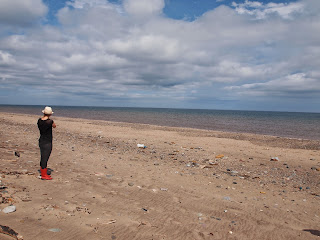Hondartza Fraga(above)is an artist working on the sea from very wittily and with a particular interest in gender in whaling.
Because I’m researching British women on whalers for my next book we met, deliberately, to talk about this under-represented subject.
She’s probably more into whales than me, and I’m more into the women on whaling vessels. But it’s such a delight to explore an obscured and obscure subject with someone so passionate.

Girls Circle, pencil on paper, part of the series 'As it falls, either remembered or not seen', 2010

Women waving, pencil on paper, 2010

Mappa, digital drawing, 2010
Mappa is a combination of a doily with the polar map of the Arctic. The subtle references to gender are in the use of the doily as a domestic object, normally associated with women's craft. They contrast to the maps which evoke 'masculine' subjects such as navigation, exploration, and dominion.
In whaling historiography it’s almost impossible to find even a sentence about British women who were whaling wives – and may even have been aboard disguised as boys.
The best way to tackle the gap in knowledge seems to be to read Joan Druett’s Petticoat Whalers, (see pictures below, of the cover and of Joan looking at an old book on whaling) which is about the US and Antipodes, and use it to wonder how the British picture differed.


Hondartza was drawn to whaling in 2009 by seeing some photographs of beached whales. And she began to combining old photographs into her own drawings in a project called As it Falls: either remembered or not seen.
Website (www.hondartzafraga.com/blog/drawing)
Then she became the Leverhulme Trust’s Artist-in-Residence at the Maritime History Studies Centre, University of Hull, with the backing of Michaela Barnard, a lecturer there.
The result was the exhibition “…a still better seaward peep”: An Artistic Perspective on Whales, Whaleports and the Marine Environment. This was displayed in six venues in Hull last year.
Hondartza’s currently raising fund for the new project Curio•sea•ty in Kickstarter, with artist Lorna Barrowclough. Link:
https://www.kickstarter.com/projects/1552753362/curioseaty
Her next steps are:
• A solo exhibition in Santander in May (see her website for news): http://www.hondartzafraga.com/
• Possibly a book about looking at the sea
• She also hopes that some situations, e.g. museums, will offer her residencies
• In August she and Lorna are going to New Bedford, the key US town in whaling history, as part of Curio•sea•ty, in order to document and research objects from its maritime collection. Her maritime works will also be included in a group show at Wayfarers, Brooklyn
• She’s looking at textiles, including knitting, as a way to think one of women’s connections with whaling and fishing – knitting ganseys and making nets
So what do we now understand about gender and whaling, or even women and whaling, now that we’ve met (albeit in a Leeds patisserie far from trypots and harpoons)?
I continue to be struck by the absence of women, British women, from whaling history. If she can’t find women, and I can’t, after huge efforts, then who can? And why are these British women absent – in a way that US women are not?
The answers may be:
• Fewer British women went than did US (and it was probably because voyages were shorter – and maybe superstitions stronger?)
• Families later didn’t see the whaling voyager’s diaries and letters as records worth keeping and donating to museums.
One of the great uses of art – visual arts and fiction – is that it can suggest ways to understand a subject when too little is known about it. So … that’s what needed.

No comments:
Post a Comment